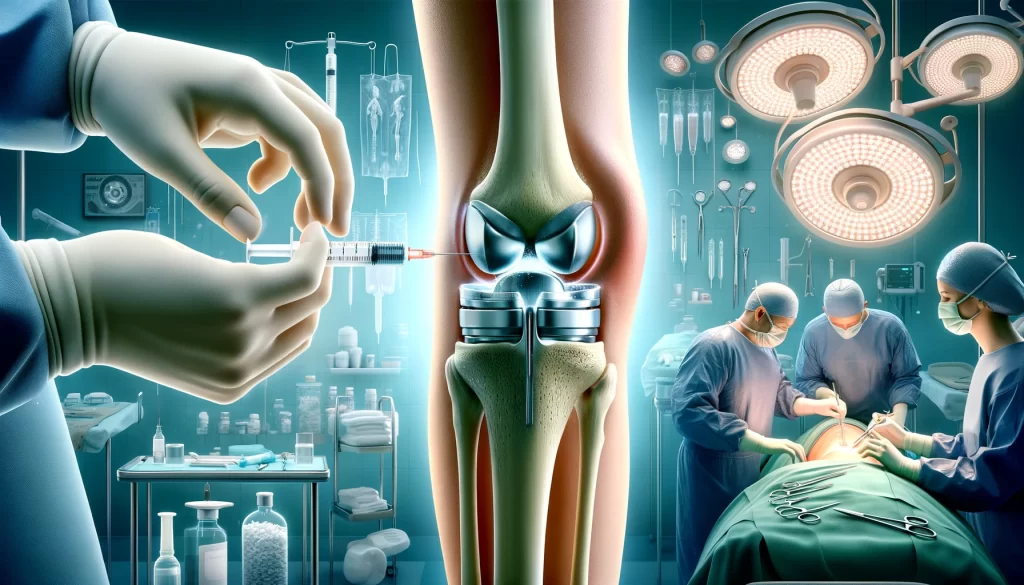Knee injections and knee replacement surgery are common treatments for your knee osteoarthritis. These injections are more common during the early stages while knee replacement surgery is more common in the extreme cases. Knee pain can take several forms which may be sharp pain, burning sensation, uncomfortable swelling, stiffness or aches. The pain can get worse at night and the knee may feel somewhat unstable. People living with severe knee pain may restrict their function and mobility which interferes with overall quality of life.
The common cause of severe knee pain in adults is osteoarthritis. This progressive arthritis form results in the wearing away of knee joint cartilage. Knee osteoarthritis, a health condition, can affect young people with a history of knee injury, not just older adults.
Knee pain treatments depend on the severity of the pain and how advanced the damage seem to be. It is possible to manage mild pain by taking over-the-counter and non-steroidal anti-inflammatory drugs (NSAIDs), such as naproxen (Aleve) or ibuprofen (Advil) with physical therapy or supportive knee brace. More extreme pain may require medical treatment when it affects your daily work, routine activities or exercise.
Different types of knee injections for pain
When conservative treatments do not seem to be effective, the doctor suggest taking injections to lessen the discomfort and restore normal functioning.
You will find various types of injections to lessen the inflammation in your knee joint which help with mobility and pain for several months or more. The right choice can be evaluated based on your symptoms and medical record.
The risk of getting side effects by taking knee injections is rare but may include pain and infection at your injection site.
-
Corticosteroids
Also called cortisone, these injections are usually the first line of treatment to lessen joint inflammation. Cortisone can be injected alone or combined with an anesthetic; pain relief generally starts in a few days and lasts for several months. Most doctors suggest restricting cortisone injections for the knee to four times a year in arthritic knees. Use cortisone injections cautiously in less arthritic knees to avoid potential cartilage damage from repeated doses. Though it is rare, some people might experience thinning of the skin around your injection site several months later that might last for almost one year.
-
Hyaluronic acid injections
Hyaluronic acid (HA) is a gel-like substance present naturally in synovial fluid which lubricates the joints and help move smoothly. Osteoarthritis seem to decrease the production of synovial fluid. Hyaluronic acid injections for your knees are also called gel injections or viscosupplementation. These can help to replace it. You may require one injection or several spaced within a week to get rid of stiffness and pain and the results usually last for almost six months. Though HA injections might not help in each case, they carry little risk to patient.
-
Platelet-rich plasma (PRP) injections
PRP is a kind of regenerative medicine which means it uses natural abilities of your body to heal properly. PRP injections use parts of your blood to treat inflammation of the joint and pain. Platelets are blood cells that can promote tissue growth, healing and plasma is the liquid part of your blood. In PRP treatment, the doctor draws several blood tubes from your arm. They then spin them in a centrifuge machine to separate the plasma and platelets. Platelets release growth factors which repair damaged tissues in a natural way. Its effectiveness in the knee is not known as PRP is a new treatment and is still believed to be experimental.
-
Arthrosamid
Arthrosamid is a new kind of injection to lessen the pain. It involves injecting Polyacrylamide Hydrogel into the osteoarthritic knee joint for providing cushion, improving lubrication, joint function and lessening knee pain. This is an injectable implant and when injected into your knee joint, it will attach to synovium and then function in the form of “scaffolding” for improving overall function of the knee. It is a non-absorbable and non-biodegradable hydrogel material that the body will not absorb to provide lubrication and cushioning within your knee joint for a prolonged timespan.
Knee replacement surgery
If injections and other treatments do not give relief or knee osteoarthritis is severe, knee replacement surgery is considered to be the best option. When performing this procedure, the surgeon removes damaged parts of the thigh and shin bones for making up knee joint and replaces them with the combination of plastic and metal implants.
If one knee part gets damaged, a partial knee replacement may be the right solution. Patients with restricted osteoarthritis damage are young. Those with extensive damage may need total knee replacement surgery. It is possible to perform both the procedures with minimally invasive surgical methods requiring fewer and smaller incisions than the conventional “open” surgery. The minimally invasive knee replacement surgery has several benefits which include less bleeding, pain, shorter stay at the hospital and quicker recovery.
Knee replacement surgery usually requires 1-2 hours and patients have to spend one night in the hospital. After the surgery, patients work with a therapist to regain strength and range of motion in their knee. They can get back to their routine activities within three to six months and will need full recovery within one year.
Every part of knee surgery puts a lot of stress on your body from anesthesia medication to the surgery. The body begins to heal after the surgery and even the healthiest person may take almost one year to recover completely. Generally, postponing surgery is the most suitable option though there are other alternatives to your knee replacement surgery. Patients need to discuss all possible options with the doctor and get a second opinion before making their treatment decision. Feel free to talk to a doctor and consider arthrosamid injection for a better outcome in knee osteoarthritis.

